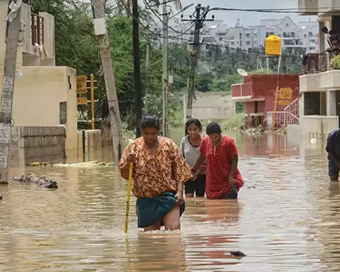 PM Modi visit USA
PM Modi visit USA Only the mirror in my washroom and phone gallery see the crazy me : Sara Khan
Only the mirror in my washroom and phone gallery see the crazy me : Sara Khan Karnataka rain fury: Photos of flooded streets, uprooted trees
Karnataka rain fury: Photos of flooded streets, uprooted trees Cannes 2022: Deepika Padukone stuns at the French Riviera in Sabyasachi outfit
Cannes 2022: Deepika Padukone stuns at the French Riviera in Sabyasachi outfit Ranbir Kapoor And Alia Bhatt's Wedding Pics - Sealed With A Kiss
Ranbir Kapoor And Alia Bhatt's Wedding Pics - Sealed With A Kiss Oscars 2022: Every Academy Award Winner
Oscars 2022: Every Academy Award Winner Shane Warne (1969-2022): Australian cricket legend's life in pictures
Shane Warne (1969-2022): Australian cricket legend's life in pictures Photos: What Russia's invasion of Ukraine looks like on the ground
Photos: What Russia's invasion of Ukraine looks like on the ground Lata Mangeshkar (1929-2022): A pictorial tribute to the 'Nightingale of India'
Lata Mangeshkar (1929-2022): A pictorial tribute to the 'Nightingale of India' PM Modi unveils 216-feet tall Statue of Equality in Hyderabad (PHOTOS)
PM Modi unveils 216-feet tall Statue of Equality in Hyderabad (PHOTOS)The Badminton Association of India (BAI) has announced a 14-member-strong India squad for
- Men’s Sr Hockey Nationals to be played in division-based format from April 4
- Mensik denies Djokovic 100th title in Miami final
- KIPG: Son of a vegetable vendor, Bihar’s Jhandu Kumar eyes Worlds, 2028 Paralympics
- Hardik Singh credits hard work and team unity for receiving HI Midfielder of the Year award
- Djokovic, Alcaraz land in same half of Miami draw
240 elephants spotted in north Bengal Last Updated : 05 Apr 2017 07:35:33 PM IST 
(File Photo)
Around 240 elephants were spotted in a 900 square km survey area in north Bengal in the pan-India synchronised elephant census, indicating the animal's numbers may have increased in the are, an official said on Wednesday.
"Around 240 elephants were spotted while direct counting in the small sample survey area of 900 sq kms in north Bengal. It indicates the number of the animals is high and has increased. This is not the total count. We are waiting for the dung decay assessment and the statistical analysis... so it will take a few months to arrive at the final number," Bengal's Chief Wildlife Warden Pradeep Vyas told.
Deploying direct and indirect counting methods, for the first time, states in east and northeast India, including West Bengal, carried a synchronised elephant census beginning on March 27.
The census for the region concluded on March 29.
Four zones (north, south, east and north-eastern zone) have been demarcated to count elephants in the all-India effort. Separate dates are allotted to each of the zones to conduct the count.
Apart from direct sighting, forest officials and experts will deploy dung-decay assessment as well, for accuracy.
Dung-decay method relies on estimating the pachyderm population size by counting dung piles and understanding how often elephants defecate and how fast dung piles decay.
The synchronised estimation will help in shedding light on demography and migration patterns.
In the second week of April, first phase of census in South Bengal will begin.
South Bengal is part of the east zone comprising Odisha, Jharkhand, and Chattisgarh, he said.IANS For Latest Updates Please-
Join us on
Follow us on








172.31.16.186







